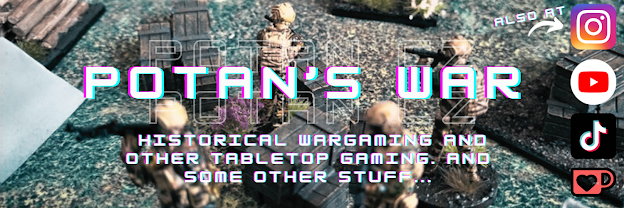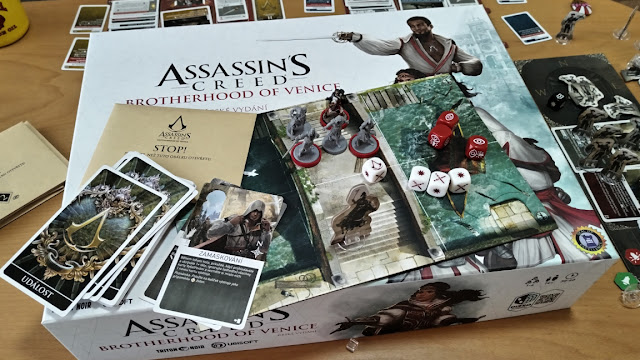Assassin's Creed: Brotherhood of Venice - a review of an adaptation that honours the principles of the video game franchise
Once upon a time, the Assassin's Creed video game franchise saw a very successful kickstarter campaign for the tabletop adaptation Assassin's Creed: Brotherhood of Venice, which after years of waiting finally reached backers.
The game is co-operative for 1 to 4 players, who take on the role of four Assassins who have to help Ezio establish a new branch of the Assassin Brotherhood in Venice and find a piece of Eden before the Templars do.
The gameplay is a bit like the old computer Commandos, where you have to plan your Assassins' movements so that you can kill the guards without triggering any alarms and leave the map safely after completing the objective. Which is no coincidence, as Triton Noir's previous game, V-Commandos / V-Sabotage, was a de facto unlicensed adaptation in which you played as a WWII-era group of saboteurs, and from the looks of it, the games share some of the mechanics.
On the map, which is always set up for a specific mission, you have one or more quests (sometimes some secret or changing during the game), a couple of guards, an access point for the assassins, and places where enemy reinforcements will come from at the end of the round. Their number is random and also depends on whether or not an alarm has been triggered.
The alarm can be raised in three ways: the guards find a dead body, encounter an assassin (who must roll a detection test on the dice to see if the guards notice or remain incognito), or during a fight in which you use "noisy" weapons. If you kill someone with a hidden blade, dagger or shoot them with a bow, you won't raise an alarm, but if you take someone over the head with a halberd or shoot them with a pistol, you won't avoid the alarm even if you kill all nearby enemies.
Sneakily, or with a big thud?
All in all, these aren't groundbreaking mechanics, and with great exaggeration, Assassin's Creed: Brotherhood of Venice is purely about getting the characters to "run" properly at the start of the game, checking which way the guards are moving, and then gradually taking them out and moving on to the mission objective. It's not overly complicated, but it's true that simplicity is power, and the game is incredibly fun even without complex mechanics. Regardless of whether you play it safe from the shadows or try your luck (and dice) with sword in hand.
In fact, the game can be played two ways, just as it was with the video game Ezio. Either the stealthy approach of dodging guards and possibly killing them one by one, or going through the front door with a solid weapon in hand and believing in the luck of the fight. It's not difficult either - characters have lives, weapons have various bonus attributes, and most importantly a given number of dice to roll, which are just " symbol" six-sided dice. A hit takes off a health, so again, nothing complicated.
The variety of play styles is also aided by a choice of four characters that subtly guide the player on how to play as them. Even in the single-player mode you have to take at least two assassins, but otherwise the game works in two, three and four anyway, with only the number of enemy reinforcements and what characters, and therefore their special rules, will be on the board.
We have Claudio, who is a true silent assassin with hidden blade bonuses thanks to his abilities; Alessandra, on the other hand, is a walking tank with bonuses to health and combat; Bastiano has a detection bonus and can thus be incognito for most of the game; and Dariâ doesn't excel at anything herself, but is a support character who returns action points to the team, can alter enemy movements, or influence random events.
Requiescat in pace
In addition to their special abilities (which improve and increase as they level up), heroes also collect weapons and equipment that further deepen their playstyle. Role selection and planning is most important at the beginning of the campaign, when you need to act with real deliberation and not raise the alarm at any cost, which can be really deadly for the Assassins.
In the middle of the campaign, the game runs at its absolute best. You can already afford to make mistakes because your experienced Assassins can survive them, you understand the game well, and you know what to do to make the mission go "clean" so to speak without raising the alarm the way good Assassins are supposed to.
Of course, the problem comes towards the end of the game, when it runs a bit out of breath in this regard, even though the developers try to spice up the games with lots of surprises or bosses, but the progression through the game is still basically the same. You look to see where the enemies are, each round you check where the guards will move to and gradually get rid of them, whereupon you reach the mission objective. And so it goes on and on.
And if something goes wrong, it's not really a big deal, because the (too) high level Assassins can handle it just fine. While at the beginning of the game assassins have 3 life and swords giving at most 2 damage per fight, by the end of the game they all have at least 7 life and fight with 4 dice. Of course, the guards aren't left behind as they have one attack and one life in the first chapter, while by the end they have 4 attacks and 4 lives.
But when Alessandra walks up to a group of knights and tells them that they're all instantly dead on mediocre rolls, and she hasn't even used all of her special abilities, any fear or sense of tension disappears from the game. Because you just know that Bastiano is unlikely to be detected for the entire mission, Claudio silently takes out all the lone guards with a silent blade, and when things eventually do go wrong, or a spot needs to be cleared, Alessandra cuts loose.
It's still fun, though, and it's quite possible that we were just exhausted by the game given that we completed its entire campaign designed for dozens of evenings in a single week. The main thing is that we were absolutely delighted after finishing the campaign, and the fact that the game stumbles a bit in the endgame didn't spoil our overall impression of the campaign.
In addition to the missions that form the core of each game, you'll also spend time between maps on the base. This is represented by the side game board, where a sort of "mini-game" takes place between missions, where you assign tasks to your apprentices and allies, who then go "shopping" for gear, researching schematics for new weapons, and healing injured assassins.
Hands full of dead bodies
Assassin's Creed: Brotherhood of Venice features 26 missions in total, including 4 tutorial missions, 1 special secret mission that you may not even encounter, and 4 main character stories that are optional but deepen each character's background and unlock special equipment.
Each game is roughly an hour long (some a quarter of an hour longer, some shorter), so simple maths works out that you need some 25 hours to complete the game. If you repeat some missions (because you fail them, and the game lets you continue the campaign after the second failure), you can get to some 30-40 hours of fun with one playthrough of the campaign. Add to that the roughly 20-30 minutes it takes to unpack the game from the box each time, so it's better to dedicate a gaming table to the game where it can lie quietly between games.
On the one hand, it's great that for the not-quite-low purchase price of the game you get a more than adequate experience for many fun-filled evenings, but on the other hand, it can also be a drawback. While it's fine to play solo, much of the fun lies in coordinating your progress with your teammates, where together you devise a course of action through the map that you then implement (or try to, but you can't command the dice).
This means you need dedicated teammates who will ideally meet with you regularly for quite a long time. And anyone who's ever played a big campaign game, or even a DnD game, knows that it doesn't happen all by itself. You never know when Charles will have to go to his cousin's grandmother's guinea pig funeral...
The game keeps this in mind in theory, and allows you to deploy Assassin apprentices with no special abilities as spare/free characters that can be equipped with spare armaments from the base (which after the first few missions you'll have to arm a smaller army...). They also serve as filler characters in case an asasin "dies" in a mission and needs to spend some time in the infirmary before the doctor can put him back together.
You can also play as the character of the missing friend, but it's tricky because both wounds and equipment - both permanent and disposable - transfer between missions, so you may find that Charles is then annoyed that you threw away his throwing knives and used the parachute he'd been saving for half the game because he was too greedy to use them.
At the same time, Charles loses part of the story, so skipping it is not desirable. And if one of the players is not playing and you don't use their character, you logically don't have access to their traits, so think about whether even in a two-player game you'd rather play as two characters each, i.e. de facto full cast, which is my case and it worked great.
Apart from time, the game is relatively space intensive. I deliberately pulled out a tape measure when playing, and for larger missions you realistically need a table at least 150 by 80 cm. Converted to US measurements, that's a dining table for a family of at least six, or room to stack 36 burgers.
And preferably one or two spare chairs where you put a box of extra game components, from which you'll pull out secret story cards and add other elements to the table. Not to mention, if God forbid you want to put a glass of drink on the table...
But despite the minor criticisms, Assassin's Creed: Brotherhood of Venice is an incredibly fun game that also does a great job of capturing the essence of the source material. It makes you feel like you're really playing Assassin's Creed and not just some board game that bought a license to sell better. The artwork of the cards and components is also beautiful and stylish, fitting the style of the sourcebook and looking like it was taken from the Ezio Trilogy artbook.
Verdict:
Even though Assassin's Creed: Brotherhood of Venice is not one of the cheapest games, it will last you for several dozen hours of fun. And while it doesn't have any never-before-seen or revolutionary mechanics in its repertoire, it works great together and would have been fun without the license. With that said, it's a great addition to the Assassin's Creed franchise that's a must-have for all of its fans, Ezio fans, and PvE co-op gamers, and it has exactly what Assassin's Creed should have: Tactical planning, sneaking, parkour, twists and turns, a good story, and of course, silently killing enemies. As Ezio Auditore da Firenze would say: Molto Bene!
Also, if you find this article helpful, you can just buy me coffee. :)
Originally published in Czech on the ZeStolu portal. Unless otherwise stated, images taken from my Hobby Instagram page @Potan_CZ.








Comments
Post a Comment